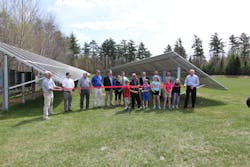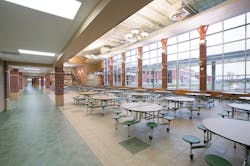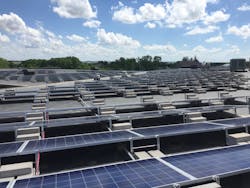Steps to Sustainability
The benefits of making a school more sustainable are abundant and well within reach. Improved physical well-being of students, teachers and staff can translate to better morale and a more vibrant learning environment. Not to be overlooked is the positive effect to the bottom line. There is not a “one size fits all” approach that can be prescribed for every school. How a school decides to increase sustainability should be unique to its vision, goals, objectives, needs, wants and requirements.
How green do you want to be? What’s important to the overall community and to your school’s culture? How a school responds to these questions can lead it in different directions. But no matter what course is chosen, the next step is to clearly articulate the current status and the ultimate goals.
Determine a baseline of electric and natural gas use and regularly compare usage with that baseline to understand patterns. In some instances, utility providers make this information readily available in graphic form online. It is not uncommon for energy providers to offer an electric lighting audit as part of an overall energy reduction strategy. Always be sure to include utility providers on a sustainability team.
Depending on the answers during this preliminary exploratory phase and based on the findings made in an initial audit, schools can increase their performance and sustainability by considering the following actions.
Choose Recycled Materials
When replacing items such as carpets or tiles, be certain to select finishes and materials that have a low-VOC (volatile organic compound) content level or contain recycled content. This can help achieve a high indoor air quality within a school.
When performing a major renovation or demolishing a facility, carefully examine how to recycle as much as possible to avoid dumping materials in landfills. Doors, fixtures and windows can be salvaged for resale, and metal scrap yards or local recyclers eagerly accept copper, steel, aluminum and other metals.
Concrete is commonly repurposed for such uses as road base, drainage zones, pavement aggregate and general fill. Large dimension lumber, timbers, plywood, flooring, molding and longer pieces of lumber can often find their next purpose in a new building or can be set aside for future projects.
Examine Your Lighting
Seek out opportunities to supplant fluorescent and incandescent lighting with LED lighting. LED fixtures use less energy and considerably fewer bulbs, resulting in significant cost savings over a school’s life. In some situations, energy providers will even offer financial incentives for converting existing lighting to more energy-efficient options.
Wisdom in Windows
Electric lighting has its place, but the benefits of daylight are still superior, so choose wisely when it comes to windows. Daylighting and views help improve student academic outcomes and enhance the mood and comfort for all building users.
In addition to the effect that window selection has on lighting, use of windows plays a tremendous role in the heating and cooling of a school facility. Judicious product placement successfully manages unwanted solar heat gains and losses, glare and lighting levels. In order to maximize performance, windows should be tinted to reduce glare, include thermal breaks in their frame and insulated glass, and use low-emissivity (low-E) coatings. Low-E coatings provide a microscopically thin (thinner than a human hair) coating that reflects heat.
HVAC is Key
As it relates to saving money and reducing energy consumption, putting in a new high-performance heating, ventilation and air conditioning (HVAC) system—or evaluating an existing system to ensure it is running at its optimal level—can be pivotal. Preventive maintenance is often the most important consideration after a system is installed.
Simple behaviors, such as changing filters consistently, can translate into monumental energy savings. The use of direct digital, and even cloud-based controls should certainly be considered as this enables maintenance staff to better monitor the equipment. On top of having more finely tuned control of systems, they can set timers and use data logging to identify trends and deliberately plan for optimal usage.
Water Matters
Faucets with shut-off sensors, waterless urinals, dual-flush toilets, low-flow fixtures and tankless water heating systems are all proven methods to save water. If a facility has outdated fixtures and systems, upgrades can often reduce annual water consumption by up to 50 percent.
Contemplate integrating rain barrels or detention basins to retain storm water for irrigation. For landscaping, use only native plant species because they typically require less water and maintenance than other vegetation.
Create Your Own Energy
There are two primary options for a school district contemplating an on-site solar PV system: purchase the system upfront with a bond referendum or cash reserves, or work with TPP (third-party participants, investors or co-owners). Two additional possibilities in some parts of the nation include leasing and Power Purchase Agreements.
Be Curious
Create and encourage a sense of curiosity and innovation to discover how a school can make itself more sustainable. Challenge team members to think in terms of the future. The tangible benefits for the community, students and teachers will be realized and provide a great role model for others to follow.
About the Author
Robert Koehler
Project Architect
Koehler is a project architect at Hoffman Planning, Design & Construction, Inc. and a member of the American Institute of Architects and the National Council of Architectural Registration Boards. He has a Master of Architecture degree from the University of Wisconsin-Milwaukee.
Matt McGregor
Project Manager
McGregor is a project manager with Hoffman Planning, Design & Construction, Inc. He is a graduate of the University of Wisconsin-Stout with a Bachelor of Science in construction.


